The deer family (Cervidae) is a large one, with 43 species populating all but two continents. Deer species include moose, mule deer, reindeer, and elk. You’re sure to encounter them no matter where in the world you live. So, how do you keep deer away?
If you live in North America, the most common deer you will encounter is the ever-present white-tailed deer (Odocoileus virginianus). These deer, like the others in the family, will eat almost any plants, bushes, fruits, nuts, and berries they can find. Deer will forage through your backyard as if it were a buffet!
Despite that, there are numerous plants that deer just don’t like. If their desired diet isn’t easily found, they will go elsewhere to feed.
White-tail deer are established from Canada to Central America. They populate heavily wooded areas, urban zones, farmland, and even cities. New York City has a robust population of white-tails in the boroughs of Staten Island and the Bronx.
With so many of them around, how can you keep deer away from your home?
Below are 13 of the best plants to repel deer. And read to the end for some other excellent tips!
1. Lavender (Lavandula)
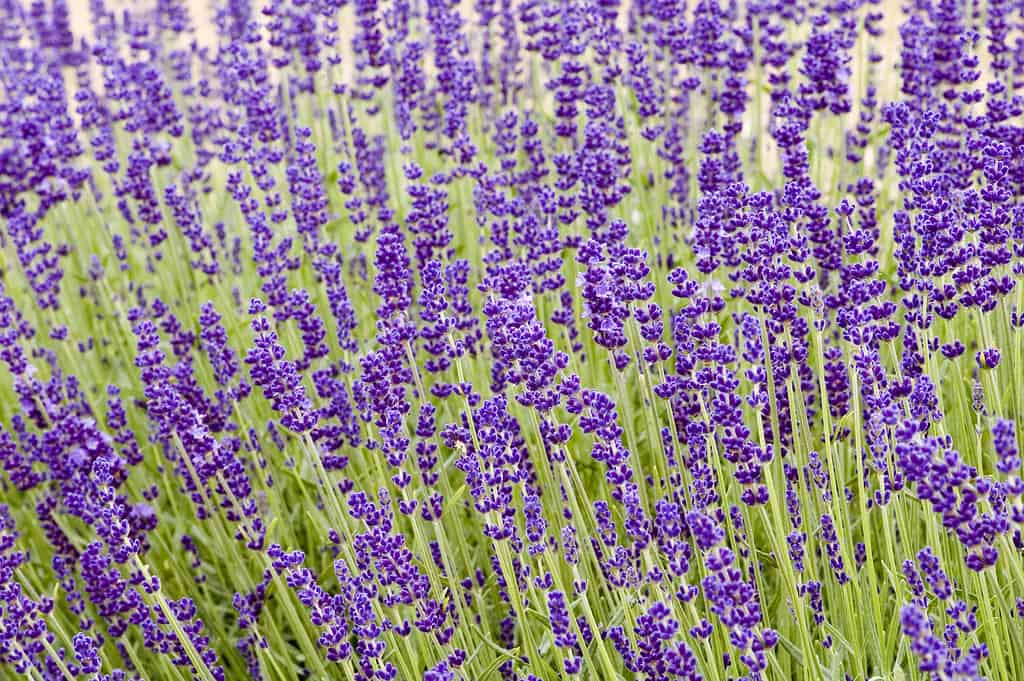
Lavender adds a calming touch of purple to a garden and will attract hummingbirds and butterflies.
©gardendata/ via Getty Images
Deer will stay far away from lavender, a beautiful aromatic plant in the mint family.
The lovely fragrance lavender gives off is the reason that deer shun it. Even fawns, who haven’t been around long enough to learn many foraging rules will avoid this plant.
There are many reasons to grow lavender in your garden. Along with repelling deer, different varieties of lavender can be used for all kinds of garden décor. From rock gardens with French lavender (Lavandula stoechas) to large areas covered with flowing English lavender (Lavandula angustifolia), the calm color of purple can add an exquisite touch to your home’s exterior. As an added benefit lavender attracts butterflies and hummingbirds that feed on its nectar.
2. Mullein (Verbascum Thapsus)

Although mullein grows low to the ground, in the summer it produces towering stalks with golden flowers.
©jonnysek/iStock via Getty Images
Mullein is another amazing plant that deer won’t touch!
Its secret ability to repel deer is its soft, fuzz-covered leaves. A deer may put a leaf in its mouth if it’s not familiar with the plant but finds the fuzzy sensation not to its liking.
Although often categorized as weeds, some species of this herb are prized in gardens. During the summer mullein, a member of the snapdragon family, will produce towering flowers with golden yellow blossoms. These blooms bear a resemblance to stately snapdragon stalks and also come in shades of pink and white.
3. Rosemary (Salvia rosmarinus)
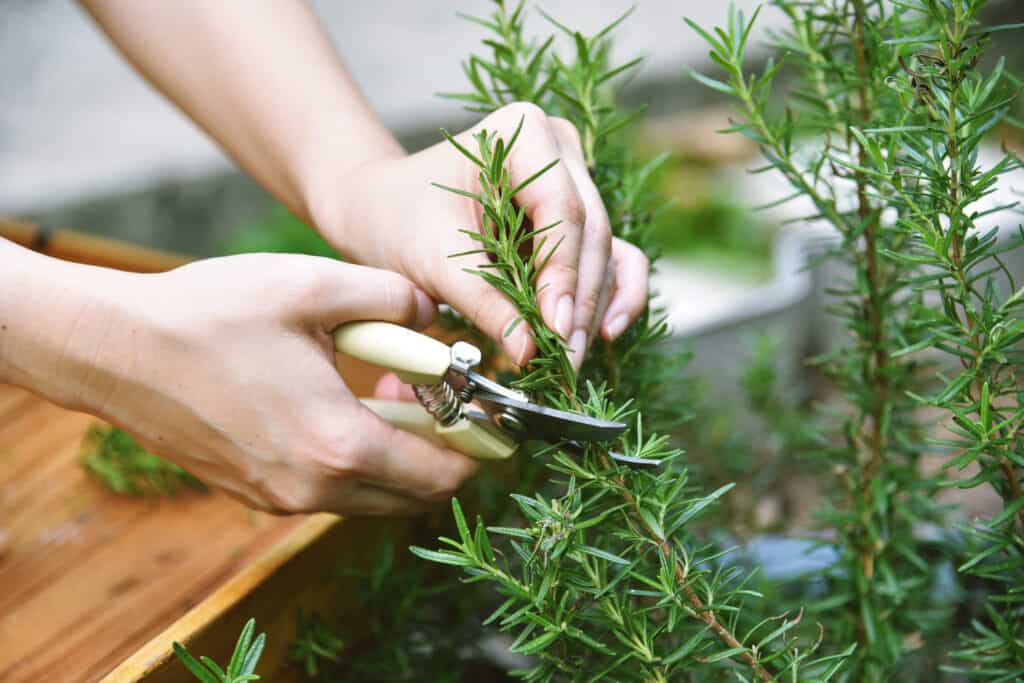
Rosemary is a favorite herb in the garden and the kitchen.
©iStock.com/Artfully79
Planting large areas of rosemary can also be very effective in keeping deer out of your yard.
Called a “shrub,” the rosemary plant consists of numerous evergreen-like spikes growing out of a thin branch. The deer-repelling properties this herb contains are also the reason chefs around the world love it — it has a very potent aroma and strong taste. Deer have an excellent sense of smell, and the fragrance of rosemary is one they steer clear of.
Rosemary offers other benefits to a garden as well. It’s extremely hardy and can tolerate winter temperatures as low as minus 4 Fahrenheit and still come back in the spring. It sports lovely blue flowers and has numerous uses ranging from aroma therapy to a marvelous herb to cook with. One favorite culinary use of rosemary leaves is to include the soft, tender tips when baking a loaf of bread.
4. Sage (Salvia officinalis)
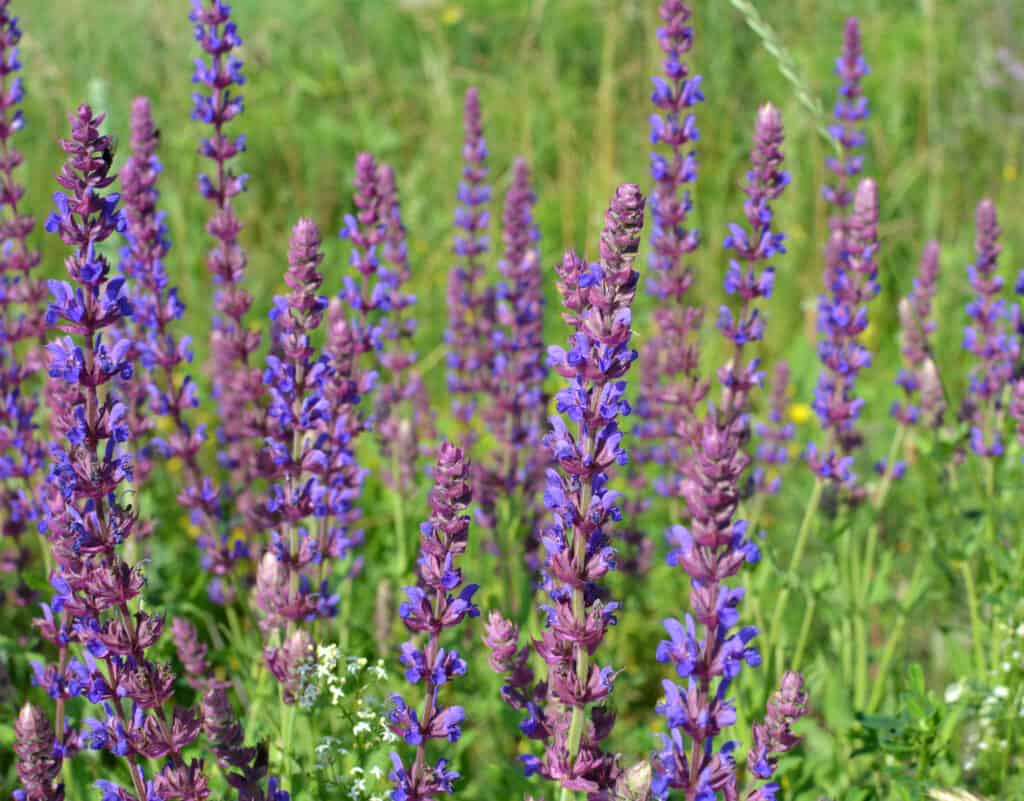
An attractive, aromatic plant during the summer, sage is in its full beauty when it flowers during the spring.
©iStock.com/Orest Lyzhechka
Another excellent deer repellant is what’s known as “common sage.”
Sage, which is in the mint family, is also a highly aromatic herb with many culinary uses. Deer avoid sage plants due to their very potent aroma. Simply rub a sage leaf between your fingers and its fragrance will fill the air. That scent is why deer will stay away from it!
There are dozens of varieties of sage plants, many of them edible. Others are simply decorative or can be used to attract butterflies and hummingbirds when in bloom.
They also have different scents. Pineapple sage (Salvia elegans) for example, has a fruitier smell and a tart taste. Both the leaves and bright red blooms, which are shaped like honeysuckle flowers, are edible.
Sage plants with stronger scents are best for keeping away deer. If you want to experiment with varieties other than common sage, simply crush a leaf and see what it smells like!
5. Lamb’s Ear (Stachys byzantine)
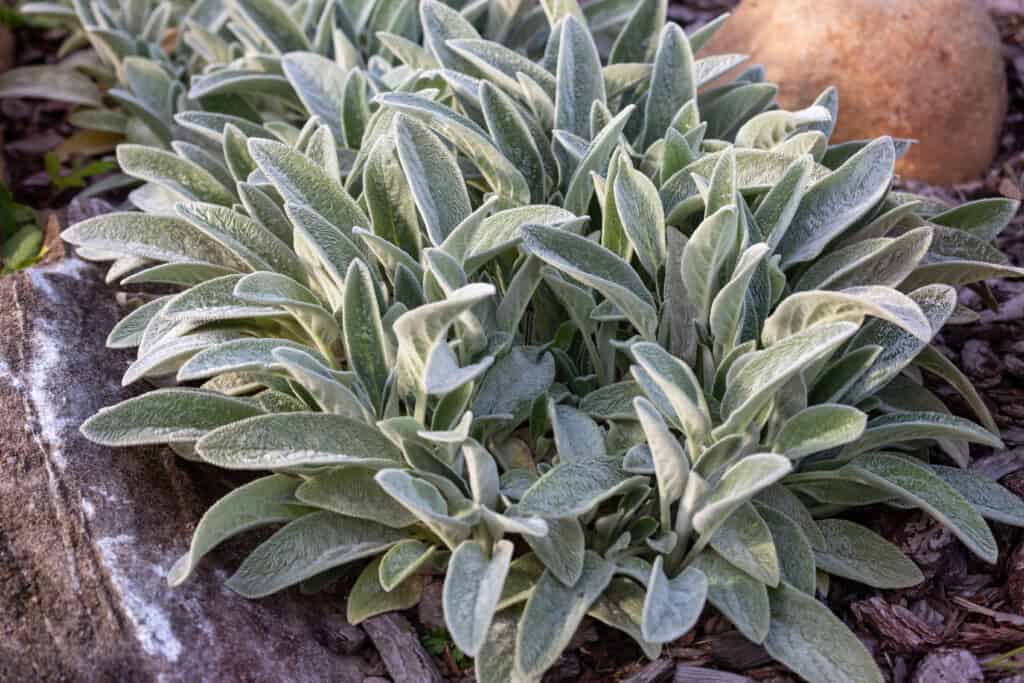
Lamb’s ear is considered a ground cover, but when in bloom will display gorgeous stalks of purple flowers.
©iStock.com/Yulia-B
Lamb’s ear is an attractive plant that repels deer due to the velvety, soft feel of its leaves. Like mullein, mentioned above, the fuzz on lamb’s ear leaves will keep deer from grazing on it.
The plant leaves look — and feel — just like a lamb’s ear. Although the leaves grow low to the ground, like a mat of soft, fuzzy greenery, lamb’s ear plants also produce amazing spikes bearing purple flowers.
Lamb’s ear thrives in well-drained soil and in environments that aren’t too humid. Don’t overwater lamb’s ear and if your climate is very hot, it will do better with some shade. In cooler locales, it can be planted in areas of full sun.
6. Mint (Mentha)
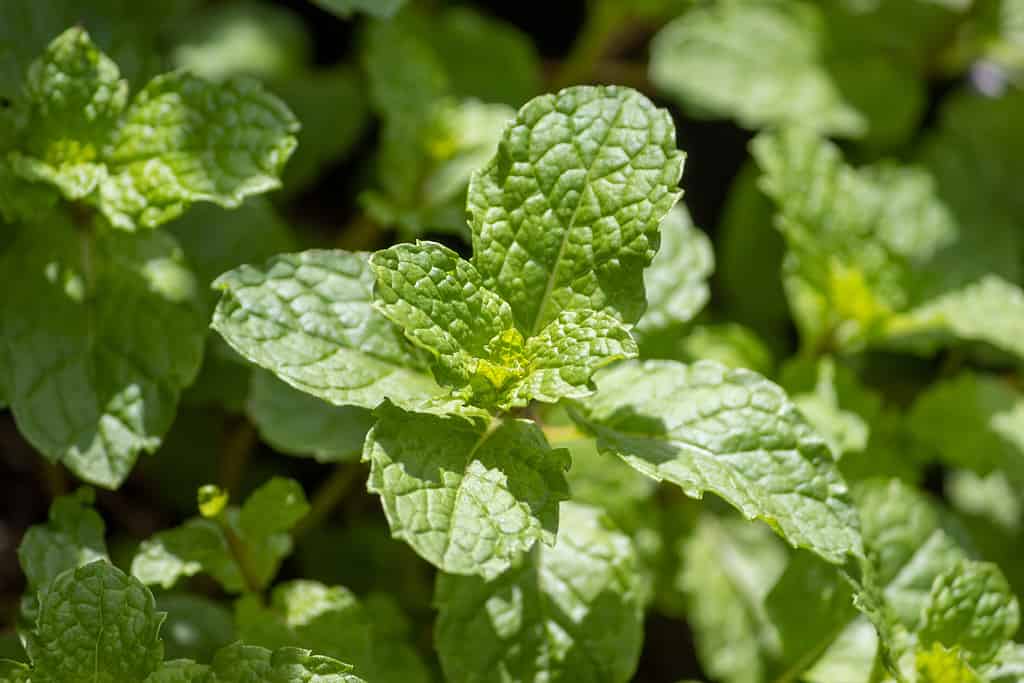
Mint is an attractive addition to a garden and one that will keep deer away.
©Leo Herdy/Shutterstock.com
There are 25 different species of mint, with the most popular used to repel deer being peppermint (Mentha x piperita) and spearmint (Mentha spicata).
Because of their strong flavors, peppermint and spearmint are among the plants that deer avoid grazing on. Those two varieties are also the most useful for teas, potpourri, garnishes, and jellies. Growing mint is easy. It enjoys full sun to partial shade and is a very hardy plant.
One undesirable tendency of mint plants, however, is their ability to rapidly take over a garden. Mint likes to journey far from where it’s planted sending out roots to sprout new leaves all over. To keep these minty wanderers contained in one area, plant them in a pot or cut them back regularly. Also, watch out for runners — a.k.a. roots — that have escaped from the pot or are making a run for it above the soil!
7. Chives (Allium schoenoprasum)
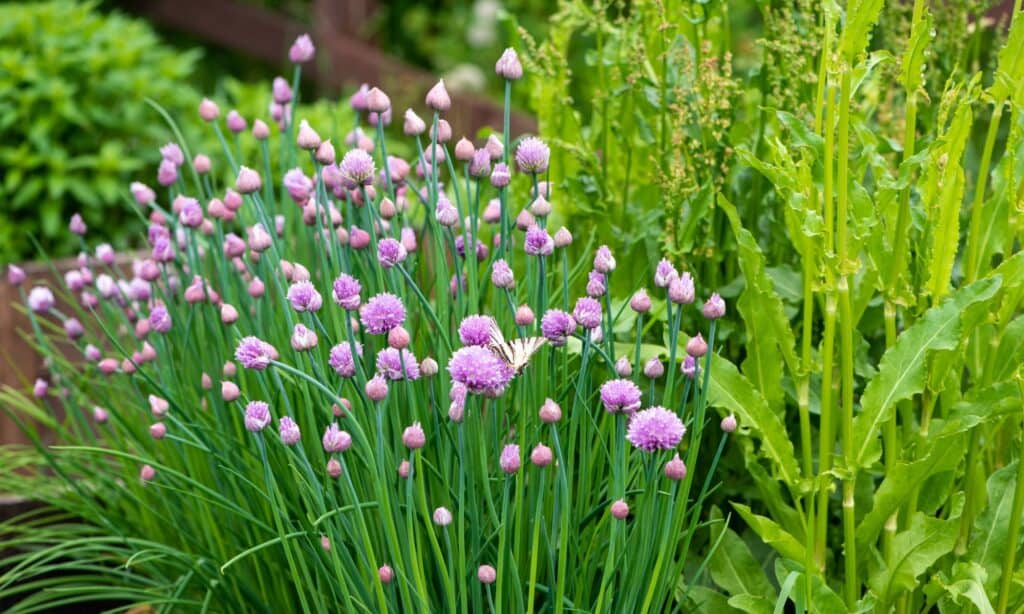
Chives are a garden trifecta. Beautiful, tasty and a herb that will repel deer.
©iStock.com/Svetlana Monyakova
Delicious to people, but not so for deer, chives, with their strong onion-like flavor, will help your garden from becoming a buffet for white-tails.
These hardy perennials, which will return in the spring, are not only tasty but very attractive additions to a garden. As an added beautiful bonus, chives produce purple flowers early in the growing season that are also a favorite of chefs. Since the flowers have an onion-like flavor, deer will shun them as well.
8. Russian Sage (Salvia yangii)
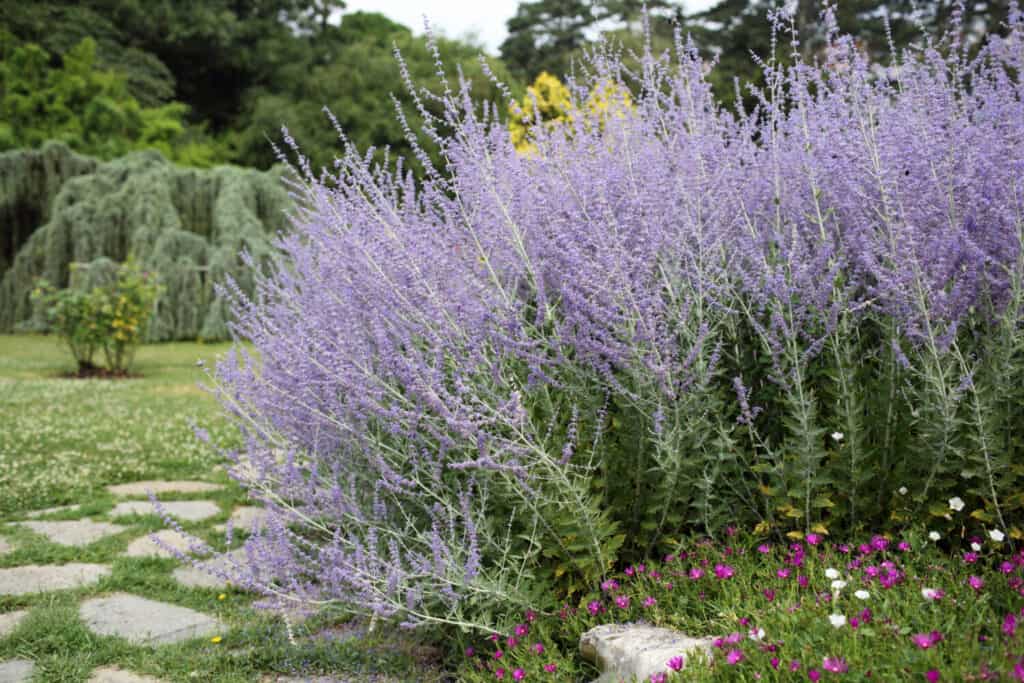
Russian sage enjoys full sun and well-drained soil. It also prefers areas that don’t have extremely high humidity.
©loflo69/Shutterstock.com
Another sage variety that repels deer is Russian sage. The fragrance isn’t quite as strong as other varieties, more of a mix between lavender and garden sage.
When planted in clusters, this gorgeous, flowering plant resembles a painting of wild purple blooms. Russian sage was only recently reclassified as part of the Salvia genus and thus a genuine sage variety. Rosemary was also put into the same genus, as it is closely related to Russian sage.
If deer march all over your yard, a generous field of this beautiful newly-minted sage variety will send them foraging elsewhere. Russian sage is fairly easy to grow in the right conditions. It does best in year-round well-drained soil, full sun, and in areas that don’t have very high humidity.
As an added bonus, Russian sage is a favorite nectar source for hummingbirds.
9. Oregano (Origanum vulgare)
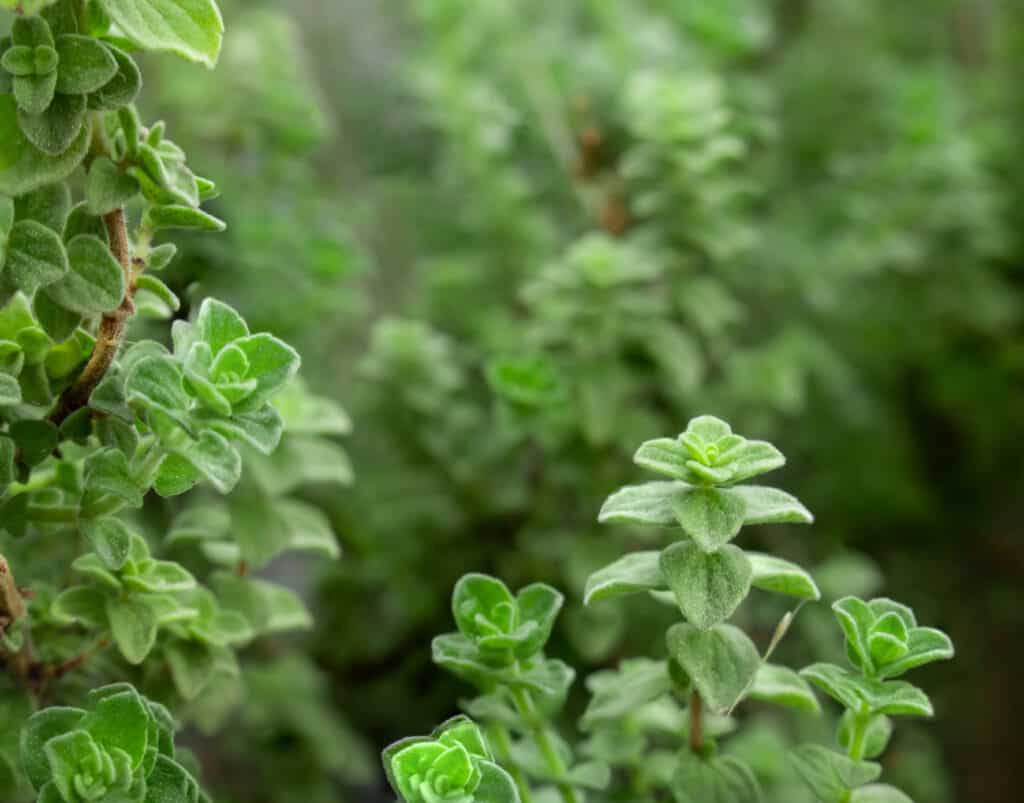
Oregano has an especially strong aroma that deer don’t like!
©Artem Kontratiev/Shutterstock.com
This aromatic and tasty herb can send deer running!
Oregano contains two strong oils, carvacrol, and thymol, that are particularly offensive to deer hoping to find a meal in your yard. A lovely ground cover, oregano shines in a rock garden and can even help protect adjacent deer-friendly plants. That’s how much deer dislike the fragrance of oregano!
An easy plant to grow, this perennial also produces delicate flower blooms. Often, the leaves are harvested for culinary purposes before the buds have had a chance to explode in a colorful carpet of pink and purple.
If you’re growing oregano, don’t fertilize it. It does best in soil that’s not very fertile.
10. Thyme (Thymus vulgaris)

English thyme (pictured) and lemon thyme are two of the most popular varieties used in cooking.
©Chris Mann/Shutterstock.com
Another herb with a pungent aroma that deer don’t like is thyme.
Whether grown in your garden for cooking or just to keep deer at bay, thyme is a beautiful “creeping” plant that can cover larger areas without much tending. There are over 300 varieties of thyme, all in the mint family and all with strong fragrances.
The most popular varieties, and the ones best for cooking, are English thyme (Thymus vulgaris) and lemon thyme (Thymus x citriodorus). Thyme is another plant that doesn’t need to be fertilized.
11. 4 O’Clock (Mirabilis jalapa)
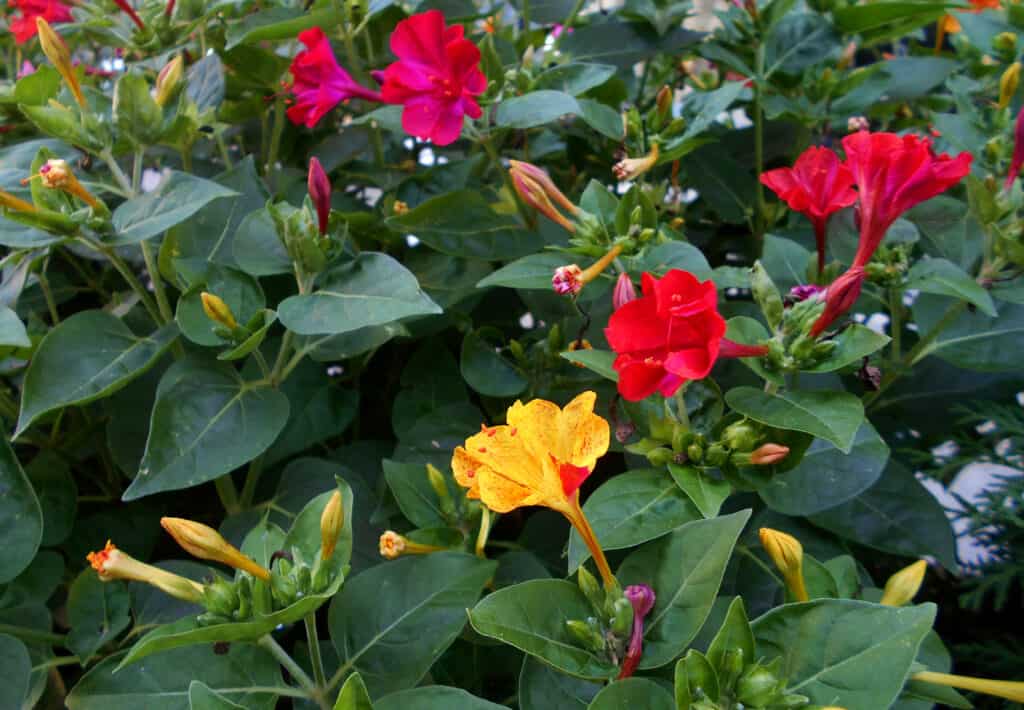
The strong aroma and bitter taste of the 4 o’clock plant means deer won’t be attracted to it.
©iStock.com/Magdevski
If you’re looking to cover some ground in your plan to deter deer, the 4 o’clock is a good choice.
An unusual-looking plant with an equally curious name, the 4 o’clock is a perennial that’s native to Peru. Deer don’t like the strong aroma and bitter taste of these plants and won’t be attracted to them unless they are without a good food source and extremely hungry.
The funny name of this plant comes from the timing of the opening of the flowers — late afternoon around 4 o’clock!
It’s also easy to grow, drought resistant, and in climates with warmer winters (U.S. Zones 7-11), will come back in the spring. In cooler locations, the plant is considered an annual (having to be replanted every spring).
The roots and seeds of the 4 o’clock are considered mildly toxic to people.
12. Bugleweed (Ajuga reptans)

Despite its name, bugleweed isn’t really a weed, although it can grow extremely fast.
©iStock.com/Albin Raj
Because of its bitter taste, deer tend to avoid bugleweed (a.k.a. blue bugle), a dense ground-cover plant that produces trumpet-like purple flowers in spring,
Bugleweed also has toxic properties, which keep deer at bay. Although deer and other grazing animals appear to have an inborn aversion to poisonous plants, studies have found that to be more of a “behavioral mechanism.” Researchers call this “cautious sampling,” using odor and taste to avoid eating toxins. Those skills and preferences are learned by fawns, following their mother’s example.
Bugleweed isn’t really a weed, but is super-easy to grow, spreading underground with runners. It can easily cover an area and not only repel deer but actual weeds as well.
13. Catmint (Nepeta racemosa)
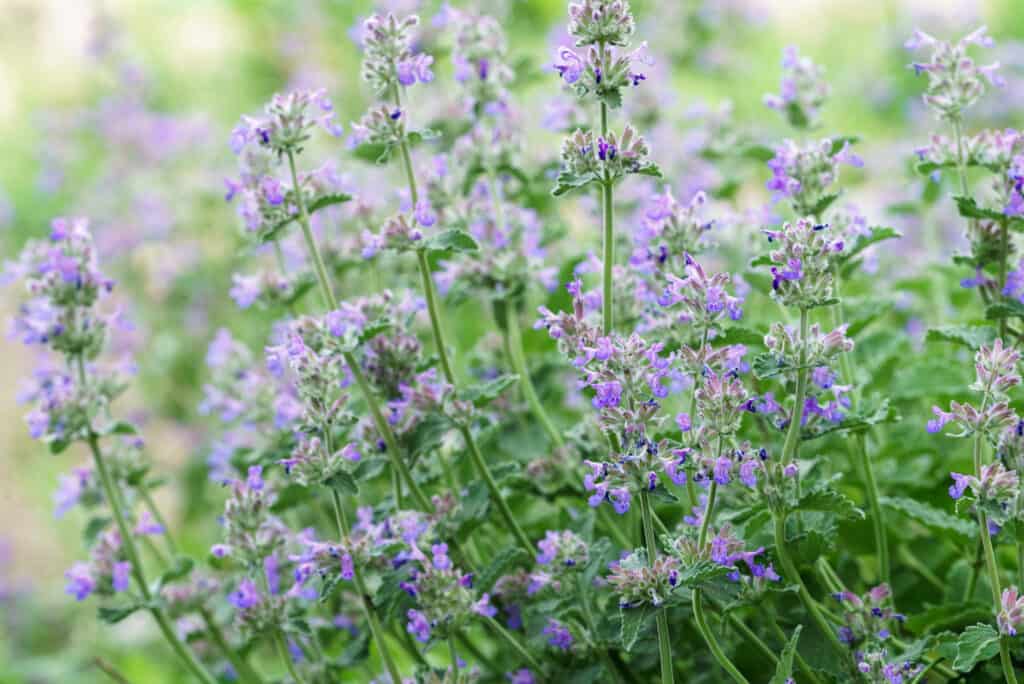
Catmint repels deer and will decorate your garden with lovely purple, blue, or pink blooms.
©iStock.com/ikuyan
Considered a natural deer repellent, catmint is a perennial herb that’s simple to grow and appreciated by pollinators.
Unlike catnip, a different plant, this member of the mint family won’t attract cats to your garden! The plant has lovely dark green leaves, but its true beauty shows when spikes of flowers appear in shades of blue, purple, or pink. Catmint can bloom throughout the summer season.
Other Ways to Repel Deer

White-tailed deer can be found in heavily wooded areas, urban zones, farmland, and even cities.
©Jim Cumming/Shutterstock.com
Along with using plants that deer don’t like, there are some other ways to repel these majestic but often destructive backyard visitors.
For example, you can put up some strategic fencing.
That doesn’t mean having to fence in your entire property. And you also don’t have to build a 20-foot-high fence to keep them out.
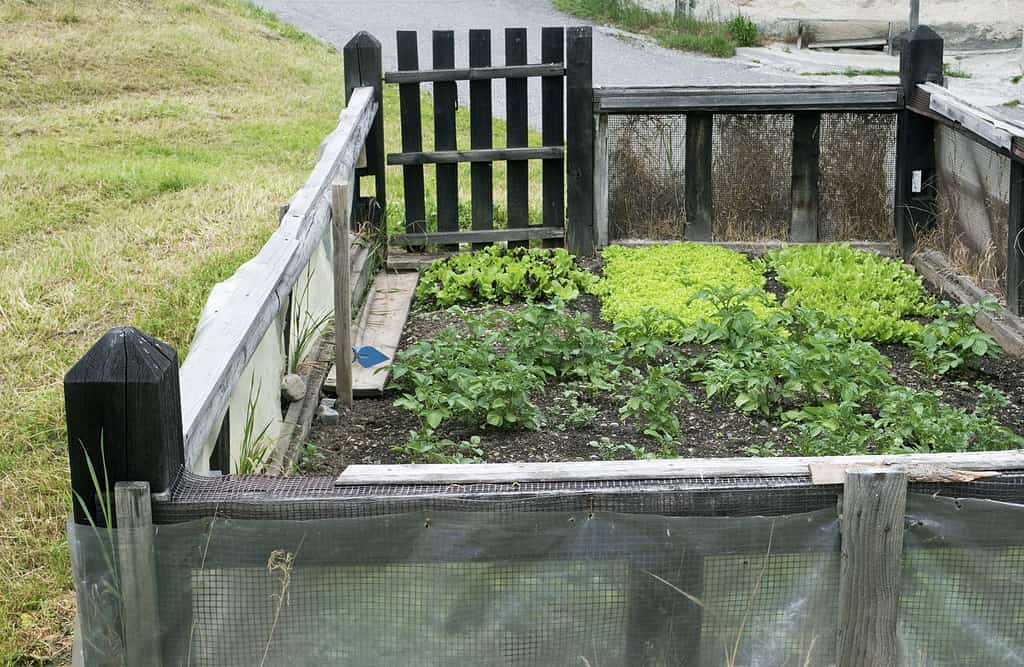
Although deer are excellent jumpers, they won’t risk jumping into a confined area such as a small fenced-in garden.
©donlucius/iStock via Getty Images
Despite the fact that these animals are champion jumpers, if the fenced-in area is small, even a moderately tall fence will do. Deer have a natural aversion to being contained or “fenced in.” Because of that, a small veggie garden can be made deer-proof with simple 4- or 5-foot garden fencing. And that’s even if it contains some of their favorite foraging foods! A rule of thumb: the smaller the space you’re fencing, the better this option works.
Another good way to repel deer is with motion-activated sprinklers. There is also a noise element to these sprinklers. Both the water and the sound will send deer running. Setting up several of these sprinklers around your yard will also deter other animals — such as raccoons — from hanging around your property.
You can also create some climbing challenges.
Deer don’t like uneven landscapes or difficult navigation. If your landscaping includes any kind of sunken bedding or built-up areas, deer will avoid it. Using large stones in an area will also help to discourage them.
Store-bought deer repellents can also be very useful but for limited areas. These products contain a variety of strong-smelling ingredients such as garlic, peppermint, and other essential oils. The downside of this method is that they must be used repeatedly and can contaminate certain edibles in your garden. They are best used for specific at-risk plants that are simply decorative.
Summary of 13 Plants That Repel and Keep Deer Away
| Ranking | Common Name | Scientific Name |
|---|---|---|
| 1 | Lavender | Lavandula |
| 2 | Mullein | Verbascum Thapsus |
| 3 | Rosemary | Salvia rosmarinus |
| 4 | Sage | Salvia officinalis |
| 5 | Lamb’s ear | Stachys byzantine |
| 6 | Mint | Mentha |
| 7 | Chives | Allium schoenoprasum |
| 8 | Russian sage | Salvia yangii |
| 9 | Oregano | Origanum vulgare |
| 10 | Thyme | Thymus vulgaris |
| 11 | 4 o’clock | Mirabilis jalapa |
| 12 | Bugleweed | Ajuga reptans |
| 13 | Catmint | Nepeta racemosa |
The photo featured at the top of this post is © Barb Elkin/iStock via Getty Images
Thank you for reading! Have some feedback for us? Contact the AZ Animals editorial team.







